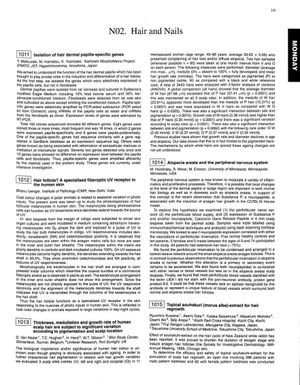N02. Hair and Nails
June 1997
in “
Australasian Journal of Dermatology
”
hair dermal papilla cells melanocytes UV exposure white hairs menopausal women hair loss nerve network alopecia areata hair follicles souhakuhi-extract baldness finasteride male pattern hair loss steroids congenital malalignment ectodermal dysplasia psoriatic patients pedal onychomycosis nail psoriasis topical calcipotriol Propecia steroids UV light white hairs baldness male pattern baldness nail fungus nail psoriasis calcipotriol

TLDR Researchers found new hair and nail genes, how hair reacts to UV, differences in white and pigmented hair growth, nerve changes in alopecia, treatments for baldness and alopecia, a toenail condition linked to a genetic disorder, and that nail fungus is more common in people with psoriasis.
In 1997, researchers made several discoveries in the field of hair and nail biology. Matsuzaki et al. identified 92 genes expressed in hair dermal papilla cells, with 8 cloned multiple times. Iyengar found that human hair follicles act as UV receptors, with melanocytes responding to UV exposure. Van Neste et al. observed that white hairs in menopausal women with hair loss were larger and grew faster than pigmented hairs. Hordinsky et al. noted changes in the nerve network around hair follicles in alopecia areata patients. Kuwana et al. reported hair regrowth in baldness patients using souhakuhi-extract. Kaufman showed that finasteride improved scalp hair in men with male pattern hair loss. Olsen found steroids effective in treating alopecia areata. Campo Voegeli et al. described a case of congenital malalignment of the great toenails linked to ectodermal dysplasia.
A study of 561 psoriatic patients revealed a 13% prevalence of pedal onychomycosis, which was 56% more likely than in non-psoriatics, and psoriatics with clinically abnormal nails had a 27% prevalence of onychomycosis. Another study with 14 psoriasis patients found that topical calcipotriol significantly improved nail psoriasis symptoms compared to a placebo.




